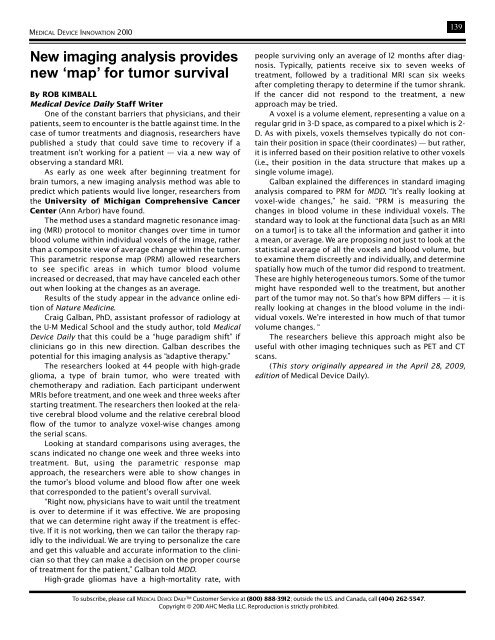MEDICAL DEVICE INNOVATION - Medical Device Daily
MEDICAL DEVICE INNOVATION - Medical Device Daily
MEDICAL DEVICE INNOVATION - Medical Device Daily
You also want an ePaper? Increase the reach of your titles
YUMPU automatically turns print PDFs into web optimized ePapers that Google loves.
<strong>MEDICAL</strong> <strong>DEVICE</strong> <strong>INNOVATION</strong> 2010<br />
New imaging analysis provides<br />
new ‘map’ for tumor survival<br />
By ROB KIMBALL<br />
<strong>Medical</strong> <strong>Device</strong> <strong>Daily</strong> Staff Writer<br />
One of the constant barriers that physicians, and their<br />
patients, seem to encounter is the battle against time. In the<br />
case of tumor treatments and diagnosis, researchers have<br />
published a study that could save time to recovery if a<br />
treatment isn’t working for a patient — via a new way of<br />
observing a standard MRI.<br />
As early as one week after beginning treatment for<br />
brain tumors, a new imaging analysis method was able to<br />
predict which patients would live longer, researchers from<br />
the University of Michigan Comprehensive Cancer<br />
Center (Ann Arbor) have found.<br />
The method uses a standard magnetic resonance imaging<br />
(MRI) protocol to monitor changes over time in tumor<br />
blood volume within individual voxels of the image, rather<br />
than a composite view of average change within the tumor.<br />
This parametric response map (PRM) allowed researchers<br />
to see specific areas in which tumor blood volume<br />
increased or decreased, that may have canceled each other<br />
out when looking at the changes as an average.<br />
Results of the study appear in the advance online edition<br />
of Nature Medicine.<br />
Craig Galban, PhD, assistant professor of radiology at<br />
the U-M <strong>Medical</strong> School and the study author, told <strong>Medical</strong><br />
<strong>Device</strong> <strong>Daily</strong> that this could be a “huge paradigm shift” if<br />
clinicians go in this new direction. Galban describes the<br />
potential for this imaging analysis as “adaptive therapy.”<br />
The researchers looked at 44 people with high-grade<br />
glioma, a type of brain tumor, who were treated with<br />
chemotherapy and radiation. Each participant underwent<br />
MRIs before treatment, and one week and three weeks after<br />
starting treatment. The researchers then looked at the relative<br />
cerebral blood volume and the relative cerebral blood<br />
flow of the tumor to analyze voxel-wise changes among<br />
the serial scans.<br />
Looking at standard comparisons using averages, the<br />
scans indicated no change one week and three weeks into<br />
treatment. But, using the parametric response map<br />
approach, the researchers were able to show changes in<br />
the tumor’s blood volume and blood flow after one week<br />
that corresponded to the patient’s overall survival.<br />
“Right now, physicians have to wait until the treatment<br />
is over to determine if it was effective. We are proposing<br />
that we can determine right away if the treatment is effective.<br />
If it is not working, then we can tailor the therapy rapidly<br />
to the individual. We are trying to personalize the care<br />
and get this valuable and accurate information to the clinician<br />
so that they can make a decision on the proper course<br />
of treatment for the patient,” Galban told MDD.<br />
High-grade gliomas have a high-mortality rate, with<br />
139<br />
people surviving only an average of 12 months after diagnosis.<br />
Typically, patients receive six to seven weeks of<br />
treatment, followed by a traditional MRI scan six weeks<br />
after completing therapy to determine if the tumor shrank.<br />
If the cancer did not respond to the treatment, a new<br />
approach may be tried.<br />
A voxel is a volume element, representing a value on a<br />
regular grid in 3-D space, as compared to a pixel which is 2-<br />
D. As with pixels, voxels themselves typically do not contain<br />
their position in space (their coordinates) — but rather,<br />
it is inferred based on their position relative to other voxels<br />
(i.e., their position in the data structure that makes up a<br />
single volume image).<br />
Galban explained the differences in standard imaging<br />
analysis compared to PRM for MDD. “It’s really looking at<br />
voxel-wide changes,” he said. “PRM is measuring the<br />
changes in blood volume in these individual voxels. The<br />
standard way to look at the functional data [such as an MRI<br />
on a tumor] is to take all the information and gather it into<br />
a mean, or average. We are proposing not just to look at the<br />
statistical average of all the voxels and blood volume, but<br />
to examine them discreetly and individually, and determine<br />
spatially how much of the tumor did respond to treatment.<br />
These are highly heterogeneous tumors. Some of the tumor<br />
might have responded well to the treatment, but another<br />
part of the tumor may not. So that’s how BPM differs — it is<br />
really looking at changes in the blood volume in the individual<br />
voxels. We’re interested in how much of that tumor<br />
volume changes. “<br />
The researchers believe this approach might also be<br />
useful with other imaging techniques such as PET and CT<br />
scans.<br />
(This story originally appeared in the April 28, 2009,<br />
edition of <strong>Medical</strong> <strong>Device</strong> <strong>Daily</strong>).<br />
To subscribe, please call <strong>MEDICAL</strong> <strong>DEVICE</strong> DAILY Customer Service at (800) 888-3912; outside the U.S. and Canada, call (404) 262-5547.<br />
Copyright © 2010 AHC Media LLC. Reproduction is strictly prohibited.
















